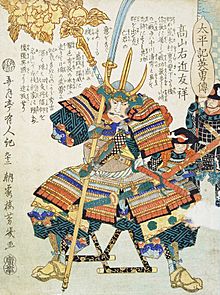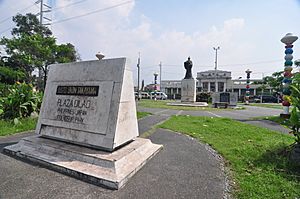Dom Justo Takayama facts for kids
Quick facts for kids BlessedJusto Takayama Ukon ジュスト高山右近 |
|
|---|---|

Illustration of Justo Takayama
|
|
| Martyr | |
| Born | Takayama Hikogorō c. 1552 Haibara, Nara, Sengoku Period, Ashikaga Shogunate |
| Died | 3 or 5 February 1615 (aged 62–63) Manila, Captaincy General of the Philippines, Viceroyalty of New Spain |
| Venerated in | Catholic Church |
| Beatified | 7 February 2017, Osaka-jō Hall, Osaka, Japan by Cardinal Angelo Amato (on behalf of Pope Francis) |
| Major shrine | Manila Cathedral, Intramuros, Manila, Philippines |
| Feast | 3 February |
| Attributes | Sword, crucifix, Samurai robes, martyr's palm |
Justo Takayama Ukon (ジュスト高山右近), born Takayama Hikogorō (高山彦五郎) and also known as Dom Justo Takayama (around 1552 – 3 or 5 February 1615) was a Japanese Catholic leader. He was a daimyō (a powerful Japanese lord) and a samurai during a time when Christians in Japan faced many challenges.
Takayama was baptized into the Christian faith in 1564 when he was twelve. For a while, he didn't focus much on his faith because of his life as a samurai. However, he rediscovered his strong belief around the age of 20. He chose to give up his important status and lands to stay true to his faith. Because of this, he was sent away from Japan to Manila, where he lived a holy life until he died two months later.
His journey to becoming a saint began when he was called a Servant of God. In 2016, Pope Francis approved his beatification. This special celebration happened on February 7, 2017, in Osaka, Japan. Cardinal Angelo Amato led the ceremony for the Pope.
His Life Story
Justo Takayama was the oldest son of Takayama Tomoteru, who was the lord of Sawa Castle. As a child, his name was Hikogorō. In 1564, his father became a Roman Catholic after meeting Portuguese missionaries. Hikogorō was then baptized and given the Christian name Justo.
After he grew up, he was named Shigetomo. But he is best known as Takayama Ukon, with "Ukon" being a special title. Europeans sometimes called him Dom Justo "Ucondono."
In 1571, he fought in an important battle as part of his coming-of-age. He was badly hurt in a duel. While recovering, he realized he hadn't been living according to his Christian faith. This made him think deeply about his beliefs.
He got married in 1574 and had three sons and one daughter. Justo and his father worked hard to keep their position as daimyō during a difficult time. He became the lord of Takatsuki Castle. He also fought in several battles under famous warlords like Oda Nobunaga and Toyotomi Hideyoshi.
During their rule in the Takatsuki area, he and his father strongly encouraged people to become Christian. Many people in their lands converted to the faith.
However, Hideyoshi later became unfriendly towards Christians. In 1587, he ordered all missionaries to leave Japan. He also told all Christian daimyōs to give up their faith. While some lords obeyed, Takayama declared that he would not abandon his beliefs. He chose to give up his lands and everything he owned instead.
Takayama lived under the protection of Maeda Toshiie for many years. But in 1614, Tokugawa Ieyasu, the ruler at the time, completely banned Christianity in Japan. This led to Takayama's exile. On November 8, 1614, he left Nagasaki with about 300 other Japanese Christians.
He arrived in Manila on December 11, 1614. There, he received a warm welcome from the Spanish Jesuits and the local Filipinos. The governor offered him money to support himself, but Takayama refused. He said he was no longer a lord and didn't want to act like one.
The Spanish government in the Philippines even offered to invade Japan to protect the Japanese Christians and make Takayama a powerful leader. But Takayama refused to be part of such a plan.
His Death
Justo Takayama Ukon became ill and died on February 3 or 5, 1615. This was only 44 days after he arrived in Manila.
After his death, the Spanish government gave him a Christian burial with full military honors, as was fitting for a daimyō. He was buried in the Jesuit church in Manila. This made him the only Japanese daimyō to be buried in the Philippines.
Statues Honoring Him
In Plaza Dilao in Paco, Manila, there is a statue of Takayama. This plaza was once home to many Japanese immigrants after they were exiled. The statue shows him in traditional samurai clothing. He holds a sheathed katana (a samurai sword) pointing downwards, with a figure of Jesus Christ on the cross hanging from it.
The University of Santo Tomas in Manila also has a statue honoring Takayama. It is located in front of the Thomas Aquinas Research Complex building.
Becoming a Saint
The process to make Justo Takayama a saint began at a local church level. All the documents were sent to the Congregation for the Causes of Saints in Rome in 1994. This officially started his cause, and he was given the title Servant of God.
There had been earlier attempts to start this process, but they failed. One attempt in 1630 didn't work because it was hard to get documents from Japan due to its isolationist policies. Another attempt in 1965 also faced problems.
In 2012, a letter was sent to Pope Benedict XVI asking for his case to be looked at again. A special report called the Positio was given to authorities in Rome in 2013.
Cardinal Angelo Amato announced in 2014 that Takayama's beatification would likely happen in 2015. This year marked 400 years since his death.
Finally, on January 21, 2016, Pope Francis approved Takayama's beatification. The celebration took place in Osaka on February 7, 2017. Cardinal Amato led the ceremony on behalf of the Pope. Takayama was recognized as a martyr because he gave up everything he had to keep his faith.
See also
 In Spanish: Justo Takayama para niños
In Spanish: Justo Takayama para niños
- Naitō Julia
- Persecution of Christians in Japan
- 26 Martyrs of Japan
- History of the Catholic Church in Japan
- Caius of Korea


